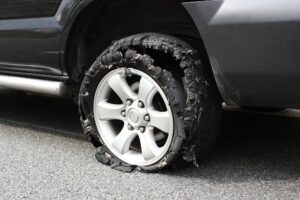According to the National Highway Transportation Safety Administration, there were over 11,000 car accidents and 562 fatalities due to tire blowouts in a recent year. These crashes are extremely dangerous because they occur at high speeds, and the driver who has lost a tire may completely lose control of their vehicle. Tire blowouts should not happen. They may be the fault of the company that made the tire, or the driver involved can be to blame because they failed to properly maintain the vehicle.
When the tire blowout was the fault of someone else, you can hold them legally accountable for the accident. They may owe you substantial financial compensation. You should always contact a car accident attorney who can work to investigate the accident and fight for you to be fully compensated for what happened. A car accident lawyer can file a claim or lawsuit on your behalf.
The Dangers of Worn or Defective Tires
 Worn and defective tires pose serious dangers to drivers, passengers, and others on the road. When tire tread becomes too thin, it significantly reduces traction—especially in wet or slippery conditions—making it harder to stop or control the vehicle. This increases the risk of skidding, hydroplaning, and losing control during turns or sudden maneuvers. Defective tires, such as those with manufacturing flaws, can suffer from tread separation or blowouts, which may cause catastrophic accidents at high speeds.
Worn and defective tires pose serious dangers to drivers, passengers, and others on the road. When tire tread becomes too thin, it significantly reduces traction—especially in wet or slippery conditions—making it harder to stop or control the vehicle. This increases the risk of skidding, hydroplaning, and losing control during turns or sudden maneuvers. Defective tires, such as those with manufacturing flaws, can suffer from tread separation or blowouts, which may cause catastrophic accidents at high speeds.
In addition to performance issues, worn or damaged tires are more likely to fail under pressure, particularly in hot weather or during long drives. Blowouts can lead to rollovers, collisions, or the vehicle veering off the road. Regular tire inspections, proper inflation, and timely replacement are essential to prevent these risks. The driver must repair or replace their tires as necessary and keep them fully inflated at all times. Drivers should also pay attention to recalls and consult a professional if they notice unusual vibrations, cracks, or bulges in their tires.
Legal Duty of Owners to Maintain Safe Tires
Vehicle owners have a legal duty to ensure their vehicles, including tires, are maintained in a condition safe for operation on public roads. This duty stems from both traffic safety laws and the general principle of negligence, which requires individuals to act with reasonable care to avoid harming others. Tires play a key role in a vehicle’s safety, affecting traction, steering, and braking. If a tire is excessively worn, under-inflated, or defective, it increases the risk of a crash.
Failing to maintain safe tires can result in legal consequences, especially if an accident occurs due to tire failure. Courts may hold the vehicle owner liable for injuries or damages caused by an accident if it is shown that they neglected routine tire maintenance or ignored visible signs of wear or damage. This includes failing to replace tires with dangerously low tread, driving with mismatched or damaged tires, or neglecting alignment and rotation.
In commercial and fleet operations, this duty is even more stringent, with regulatory requirements mandating regular inspections and documentation. Ultimately, drivers are responsible for ensuring that their vehicles—including the tires—are roadworthy. Neglecting this responsibility can lead to civil liability, fines, and even criminal charges in serious cases.
Always discuss your crash with a car accident lawyer, whether it was a single-vehicle crash due to your tire blowing or a collision caused by another driver’s blowout.
The Legal Implications of Defective Tires
Tire maintenance is not only essential for safe driving—it can also have significant legal implications when a car accident occurs. In many accident investigations, tire condition is examined to determine whether poor maintenance contributed to the crash. If a vehicle’s tires are found to be bald, underinflated, mismatched, or otherwise defective due to neglect, the vehicle owner may be held partially or fully liable for resulting damages or injuries.
Negligence is a key legal concept in these cases. Vehicle owners have a duty to maintain their cars in a reasonably safe condition. Failing to inspect tires, ignoring signs of wear, or skipping routine maintenance like rotations and alignments may be considered a breach of that duty. If this negligence can be linked to the cause of an accident—for example, if a blowout causes a driver to lose control—courts may assign fault to the vehicle owner. This can impact personal injury claims and insurance payouts and even lead to lawsuits.
Commercial drivers and fleet operators are often held to even higher standards. Federal and state regulations require regular tire inspections and documentation. Failure to comply can expose companies to steep penalties and liability in crash-related lawsuits.
In short, ignoring tire maintenance is not just a mechanical oversight—it’s a legal risk. Drivers who fail to take basic steps to ensure tire safety may find themselves facing financial consequences and legal action if an accident occurs. Maintaining tires properly is a simple way to reduce both accident risk and legal exposure.
Proving Driver Negligence in a Car Accident Caused By Tires
 Proving inadequate tire maintenance in a car accident case typically involves gathering physical evidence, expert analysis, and maintenance records. When tire failure is suspected to have contributed to a crash—such as a blowout, loss of traction, or skidding—investigators will examine the tires for signs of neglect. Common indicators include low tread depth, uneven wear, visible damage, dry rot, or improper inflation.
Proving inadequate tire maintenance in a car accident case typically involves gathering physical evidence, expert analysis, and maintenance records. When tire failure is suspected to have contributed to a crash—such as a blowout, loss of traction, or skidding—investigators will examine the tires for signs of neglect. Common indicators include low tread depth, uneven wear, visible damage, dry rot, or improper inflation.
Photos of the vehicle and accident scene can be critical, especially if they show worn tires or debris indicating tire failure. In some cases, accident reconstruction experts may be called to determine how the tire condition contributed to the crash. They analyze factors such as stopping distances, skid marks, and vehicle behavior before the collision.
Maintenance records are also key. If a driver cannot provide evidence of recent tire inspections, rotations, or replacements, it may suggest neglect. Witness testimony, repair shop documentation, and prior warnings about tire issues (e.g., from a mechanic) can strengthen the case.
Ultimately, the goal is to establish a link between the tire condition and the accident. This can be difficult, but an experienced car accident lawyer has the resources to do so. If it can be shown that the owner knew or should have known the tires were unsafe—and failed to act—this can support a negligence claim and assign liability for injuries and damages.
Contact a Car Accident Attorney Today for More Information
Have you been injured due to a tire blowout and the resulting crash? You need experienced legal representation to prove these challenging cases. Contact a Nashua personal injury attorney near you for a free consultation now.
